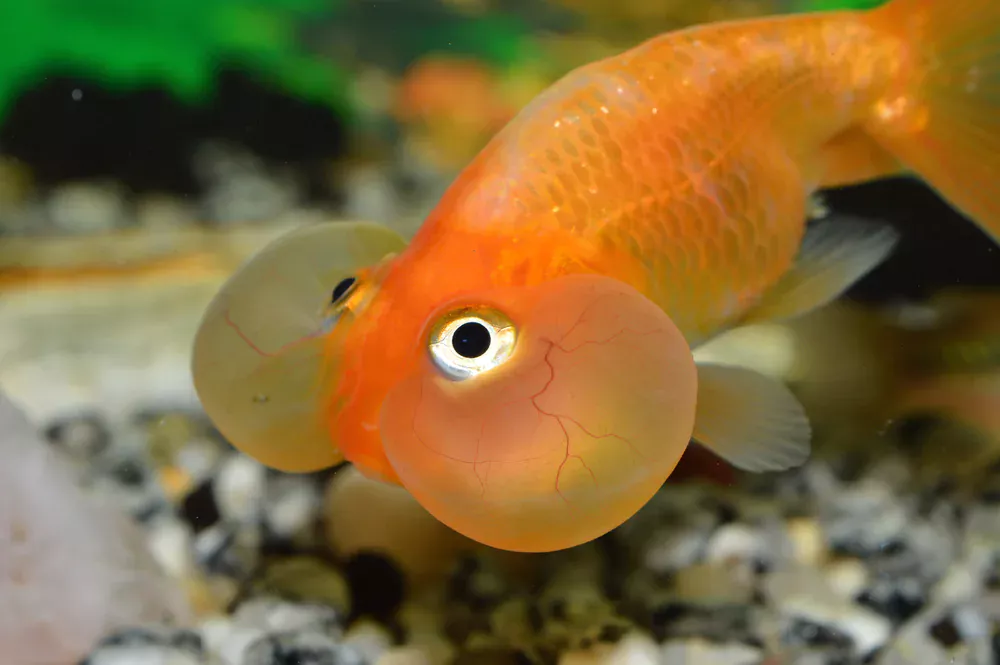we all know goldfish are one of the most popular fish in the world. They can live for years, they’re easy to care for and they come in so many different shapes and colors.
But did you know that there are also variations of goldfish with big eyes? These are called bubble eye goldfish and they’re one of the most unique types of fish you can own. Like regular goldfish, bubble eye fish need a few things like an aquarium tank with aquarium gravel or sand at the bottom of it to live happily ever after (or at least until their next meal comes around). But as well as these basics there are also some other things about bubble eyes that make them unique – like why they have big eyes! Let’s find out more about what makes these fish special:
- 1 What Are Goldfish With Big Eyes Called?
- 2 Why Do Goldfish Have Big Eyes?
- 3 Types Of Goldfish With Big Eyes?
- 4 Ideal Tank Size For Big Eyes Goldfish
- 5 Ideal Water Parameters For Big Eyes Goldfish
- 6 Setting Up Tank For Big Eyes Goldfish
- 7 Ideal Food & Diet For Big Eyes Goldfish
- 8 Behavior & Temperament Of Big Eyes Goldfish
- 9 Ideal Tank Mates For Big Eyes Goldfish
- 10 Common Possible Diseases Of Big Eyes Goldfish
- 11 Conclusion
What Are Goldfish With Big Eyes Called?
Although you’re probably used to hearing them called “goldfish with big eyes,” there are actually a few different names for this fish. Some people refer to them as telescope eye goldfish or bubble eye goldfish. They all refer to the same type of fish, but it’s important to know when someone is talking about a specific breed of fish that has either large or small eyes.
The term “big eye” refers to the relative size of the eyes compared to other parts of the body. There are two main types: Telescope Eye Goldfish and Bubble Eye Goldfish
Why Do Goldfish Have Big Eyes?
Goldfish have big eyes because of a genetic mutation. The “big eye” trait is an autosomal dominant trait that can be passed on to offspring. This means that if one parent has large eyes, their offspring will also likely have large eyes.
Most goldfish breeders consider the appearance of large eyes as a sign of bad health or disease, but not always. Some goldfish breeds are bred for their big eye appearance and others for other traits like fancy finnage or coloration.
Types Of Goldfish With Big Eyes?
There are several types of goldfish that have big eyes:
1- Telescope Goldfish

Telescope goldfish is the most common type of fish with big eyes. They have a large, round body with a small head and long tail fin.
2- Black Moor Telescopes
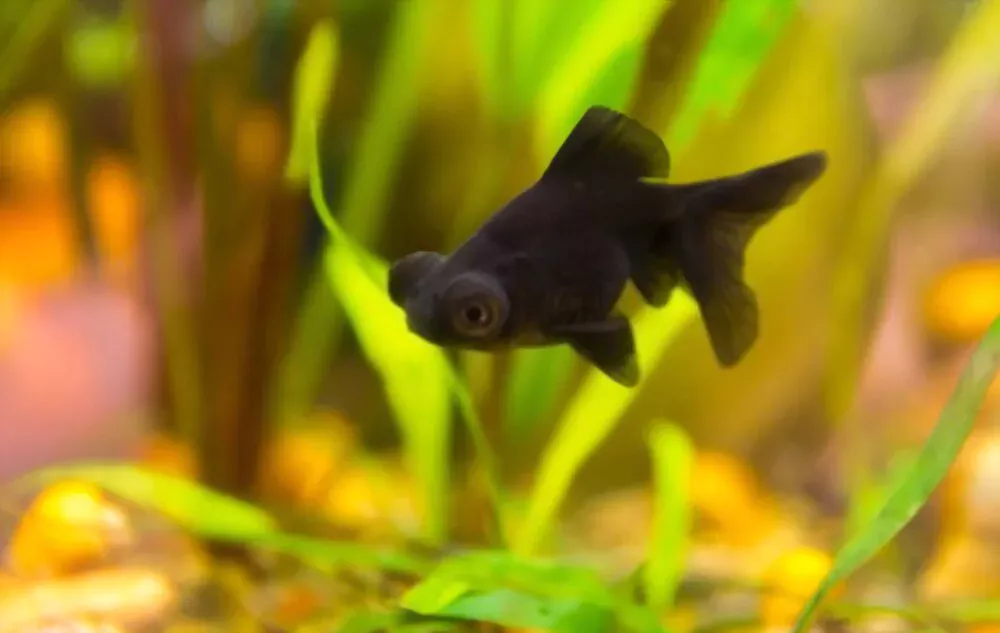
Black Moor telescopes have black dots on their scales that resemble freckles or moles. They also have spots on their fins in shades of black, red, orange, and yellow.
3- Juvenile Panda Moor Goldfish
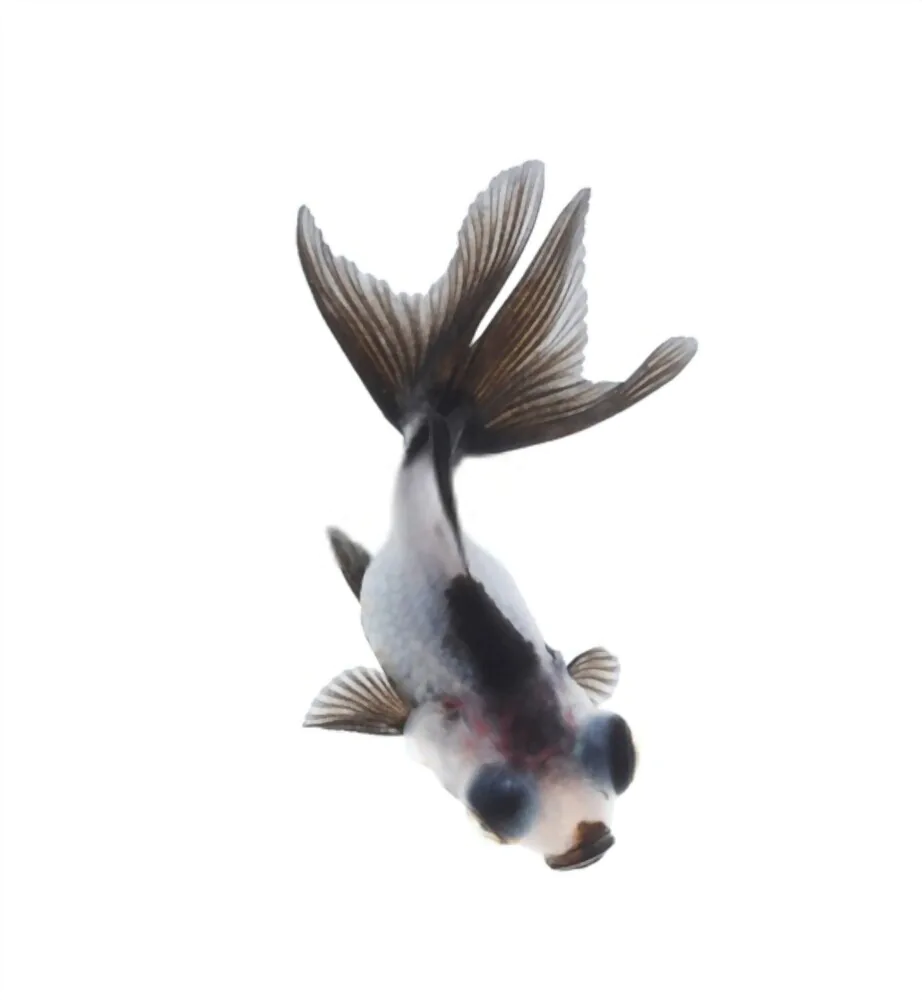
Juvenile pandas moor goldfish can be identified by their white bodies and dark stripes across the back along with two red dots at the tail end of their body (one above another).
4- White Telescope Goldfish
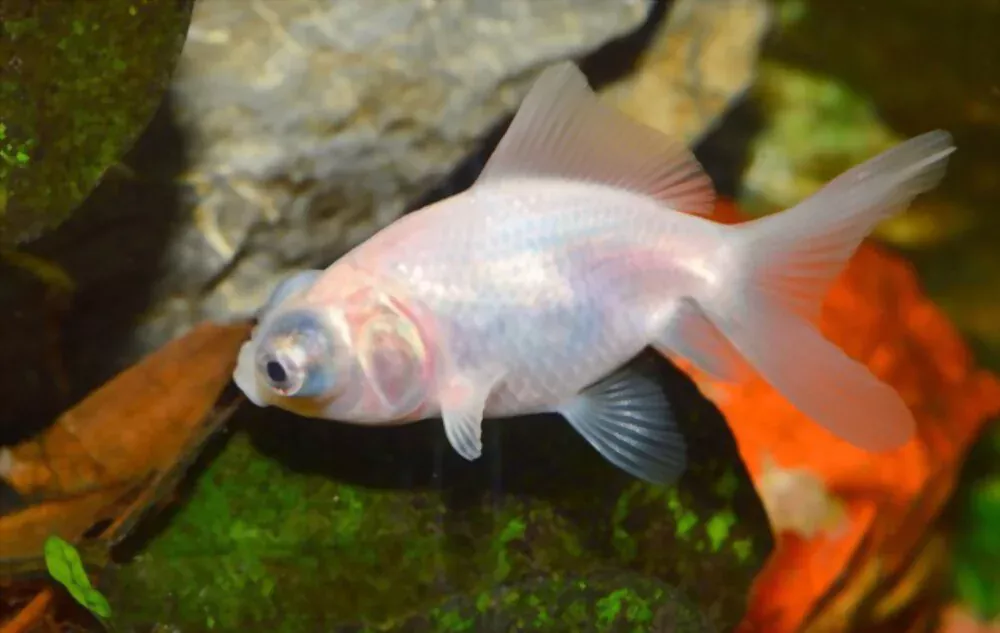
White telescopes are named for having a white body with black mottling on it which gives them an attractive appearance when viewed from above or below water level line because light reflects off these spots creating an optical illusion effect known as the iridescence effect making them appear brighter than usual.
5- Bubble Eye Goldfish
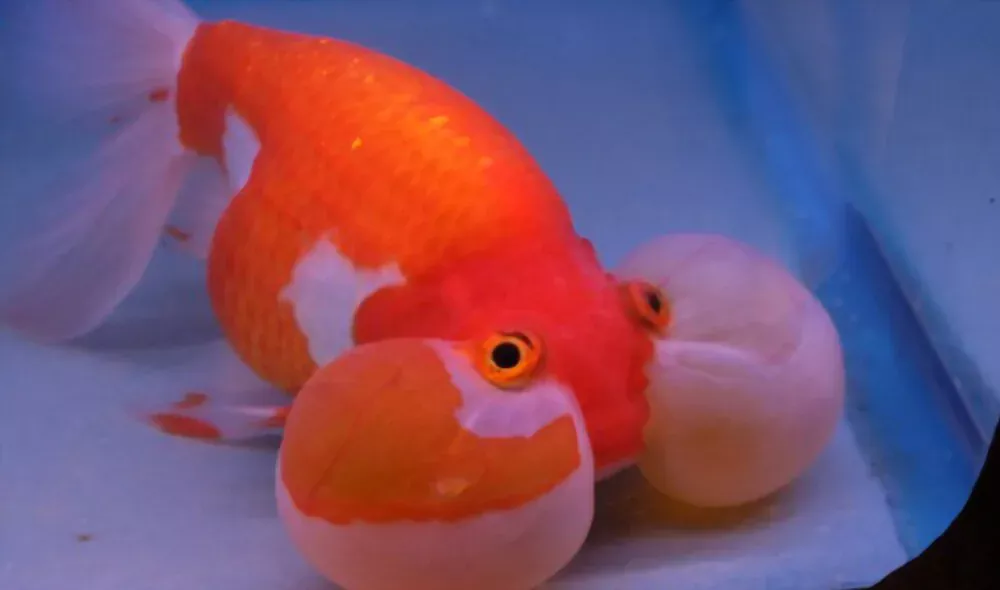
The bubble eye goldfish is the best-known of all goldfish and can be found in almost any species of a fish tank. The bubble eye goldfish has an elongated, oval-shaped body with a rounded head that is larger than other types of goldfish. Their eyes are located high on the head, giving them a big-eyed appearance.
Ideal Tank Size For Big Eyes Goldfish
The bigger, the better. There are many things that you need to consider before buying a goldfish tank, but one thing that most people forget about is size. Big eyes goldfish require more space than regular varieties because they have long bodies and their fins are larger as well. The ideal tank size for big eyes goldfish is between 10-20 gallons. The bigger the tank, the better!
Although you may think an extra five or ten gallons won’t make much difference when it comes to water quality, these fish can actually produce a lot of waste which can cause ammonia levels in your aquarium to spike if not maintained properly with frequent water changes every week or two (or more often depending on how much food they eat).
Additionally, because they’re also a bit slower swimmers than other types of goldfish – making sure there’s enough room in your aquarium will help prevent injuries caused by collisions between fish trying to get through narrow spaces at high speeds while circling around each other excitedly during feeding time!
Ideal Water Parameters For Big Eyes Goldfish
Here are ideal water parameters for big eyes goldfish:
- Water temperature should be between 65°F (18°C) and 80°F (27°C). The ideal water temperature is around 72°F.
- pH levels should be 6.0 to 8.0. A pH of 7 is ideal for Goldfish.
- Water hardness should be kept between 5 to 19 dKH
Please keep in mind these parameters are dependent on the size and number of fish you have in a fish tank.
Setting Up Tank For Big Eyes Goldfish
If you are considering setting up a tank for your big-eye goldfish, then you should definitely consider the following things:
1- Tank Shape
A round aquarium is ideal for bubble eye goldfish because it will enable you to see the eye more clearly.
2- Tank Cover
A glass lid is a must-have if your tank has no hood lighting. The lid should be made of tempered glass, which won’t shatter when dropped or bumped. It should also have a sturdy locking mechanism so that it won’t open if your fish jumps out of its water while swimming around.
3- Tank Decoration
You can choose from many different decorations, but make sure that they’re stable and won’t fall over easily. Also, keep in mind that most bubble eye goldfish prefer dimly lit spaces over bright ones; therefore, avoid placing mirrors and shiny decorations in their tank unless absolutely necessary (for example, as a focal point). They’ll also appreciate plants that give off oxygen during the night when they’re sleeping (just make sure not to put them too far away from where your fish will swim).
4- Tank Filter
Be sure to get one with good reviews on Amazon or some other reputable site before making this purchase because there are many different types available. some work better than others depending on how well maintained they are by users! If possible try buying something without too much maintenance involved since maintaining filters can be costly, especially when done incorrectly.
Ideal Food & Diet For Big Eyes Goldfish
Goldfish are omnivores. This means that they eat both plant and animal-based foods.
High-quality flake food is recommended, but you should also feed your fish a variety of diet staples such as frozen bloodworms, daphnia, and brine shrimp that are rich in protein.
Always feed them a balanced diet by including vegetable-based foods in addition to their staple diet of flakes, pellets, and freeze-dried or live foods.
Behavior & Temperament Of Big Eyes Goldfish
Goldfish in general are social animals and thrive in groups. While they may be alone in their tank, goldfish should always be kept in schools of at least 5 or more. They are active swimmers and will enjoy swimming throughout the day to explore their environment as well as play with their tank mates.
Goldfish also love to eat! They are omnivores (as I have mentioned earlier), so you can feed them a wide variety of foods including flakes, pellets, freeze-dried blood worms, and brine shrimp (which make great treats).
If you choose to feed your fish bread crumbs or other human foods it is important that these items do not contain onion powder or garlic powder as these items can cause a bacterial infection among your goldfish colony called Columnaris disease which can lead to death if left untreated.
Ideal Tank Mates For Big Eyes Goldfish
Your Bubble Eye Goldfish is a unique, delicate fish that needs to be kept in the proper environment. He will not thrive with all other goldfish, but he can get along with some types of them. You can keep your Bubble Eye Goldfish tank mates from getting aggressive and territorial by choosing the right fish for your aquarium. Here are some examples:
1- Rosy Barb
The rosy barb is one of the best fish for keeping big eyes on goldfish company because it’s so peaceful and not aggressive at all. It’s also very easy to care for and doesn’t need much space to thrive.
2- Platy Fish
The platyfish is another great fish for keeping big eyes goldfish company because it interacts well with them but isn’t too big or strong enough to hurt them (unless you have an overly aggressive one). The platy also has a lot of personalities and can be quite entertaining to watch while they swim around the tank!
3- Bristlenose Pleco
The bristlenose pleco is another great choice because it doesn’t treat your big eyes goldfish like prey, but also doesn’t bother them either! They’re really active swimmers and eat just about any kind of food that you feed your other fish, so this is a great match!
4- Hillstream Loach
The hillstream loach is a great tank mate for big eyes goldfish, especially if you plan on feeding them flake foods. They have an omnivorous diet and will eat everything from vegetables to pellets and pellets with their teeth. They are also very active, so they will keep your goldfish entertained in their own ways.
5- Hoplo Catfish
The hoplo catfish is another good choice for a tank mate for big eyes goldfish, as it does not have any teeth and does not frequently nip at the fins of its tank mates like other fish species do when they get bored or frustrated with being kept in one place for too long.
Common Possible Diseases Of Big Eyes Goldfish
Many people think that bulging eyes are the result of a disease, but it is actually quite rare. In some cases, however, it may be a sign of another problem. Here is a few other diseases that can be found in the big eyes of goldfish:
1- White Spot Disease
The most common goldfish disease is Ichthyophthirius multifiilis (White spot disease). This is spread through faeces in the water, so it is important to clean your filter regularly to prevent this from occurring. Ichthyophthirius multifiilis will also affect other fish in the tank if they come into contact with it.
2- Trichodina
Trichodina is another common problem that can affect goldfish. It causes white spots on the scales of your fish and makes them look very sickly. This can spread quickly if left untreated and can kill your fish if not treated quickly enough.
3- Flukes
Mongenean trematodes (“Flukes”) are parasitic roundworms that live in the body of your goldfish, including the fins and gills. They cause damage by eating away at internal organs, which can lead to serious health issues or even death if left untreated.
4- Costia
Icthyobodo is a disease caused by the ichthyobodo virus that affects the gills of goldfish. It is also known as “Costia” or “Gill apple disease”. The disease can be fatal, but it is easily treatable with medication and rest.
5- Anchor Worms
Learner spp. are parasites that attach to the body of your goldfish and lay eggs in its tissues, causing irritation or skin irritation, or an abscess if they rupture into the body cavity. They are most commonly found on the head and dorsal fin of goldfish, although they may also be found on other parts of the body including fins and tail base (where they cause skin damage).
Conclusion
In the end, big eyes goldfish are wonderful to own, but you should be aware of their potential health problems and signs that it might be time to take your pet in for a vet visit. Hopefully, this article has given you the knowledge you need to keep them happy and healthy for years to come. Good luck!

